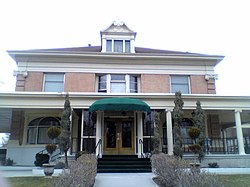Jesse Knight House
|
Jesse Knight House
|
|
 |
|
| Location | 185 E. Center St., Provo, Utah |
|---|---|
| Coordinates | 40°14′02″N 111°39′16″W / 40.23389°N 111.65444°W |
| Area | less than one acre |
| Built | 1905 |
| Architect | Ware Walter |
| Architectural style | Late Victorian, Colonial Revival |
| MPS | Entreprenurial Residences of Turn-of-the-Century Provo TR |
| NRHP reference # | 82004174 |
| Added to NRHP | July 23, 1982 |
The Jesse Knight House, also known as the Knight Mansion, was a house built for Jesse Knight, located in Provo, Utah. It was built in 1905, and added to the National Register of Historic Places in 1982. This home was designated to the Provo City Historic Landmarks Register on June 19, 1996.
Perhaps the wealthiest man in Provo at the time, Jesse Knight was born in 1845 in Nauvoo, Illinois. Jesse’s family migrated west, and reached Utah in 1850. Eighteen years later Jesse married a woman by the name of Amanda McEwan, and soon began a ranch in Payson, Utah. Following an impression that he had, Jesse began a mining operation in the Eureka area and became rich. He subsequently bought other mines, founded a bank, purchased real estate in Provo, bought the Provo Woolen Mills, and started farming and cattle interests in Canada. Throughout all of these efforts Jesse remained an active supporter of The Church of Jesus Christ of Latter-day Saints, and his mines were called the “cleanest mining camps in the west (Utah State Historical Society p. 2).” Jesse Knight died in 1921, designating much of his amassed fortune to BYU and various other institutions.
Two and a half stories tall, the Jesse Knight home was built in the Colonial Revival Style. Possessing a symmetrical facade, the detailing of the home exhibits “A broad entablature with a boxed cornice with egg and dart ornament and dentils on the frieze, swan’s neck pedimented dormers, Ionic capitals on quoins that are meant to resemble pilasters, pilasters on the corners of the dormers and flanking the first floor windows, and the Ionic columns (Utah State Historical Society p. 2).”
Built between the years 1893 and 1908 in Provo, Utah, this group of Victorian mansions are historically significant and represent not only fine architecture but some of the most successful men of the city and state at the time. These mansions include the Charles E. Loose House, the William H. Ray House, the Knight-Allen House, the John R. Twelves House, the Jesse Knight House, the Knight-Mangum House, and the Thomas N. Taylor House. All of these homes derive from the high style: Eastlake, Shingle, Craftsman, Italianate, Classical, Moorish, Colonial, and Romanesque. Made primarily of brick, these homes exhibit the finest architecture and most ornate detailing to be found in the city of Provo.
...
Wikipedia

